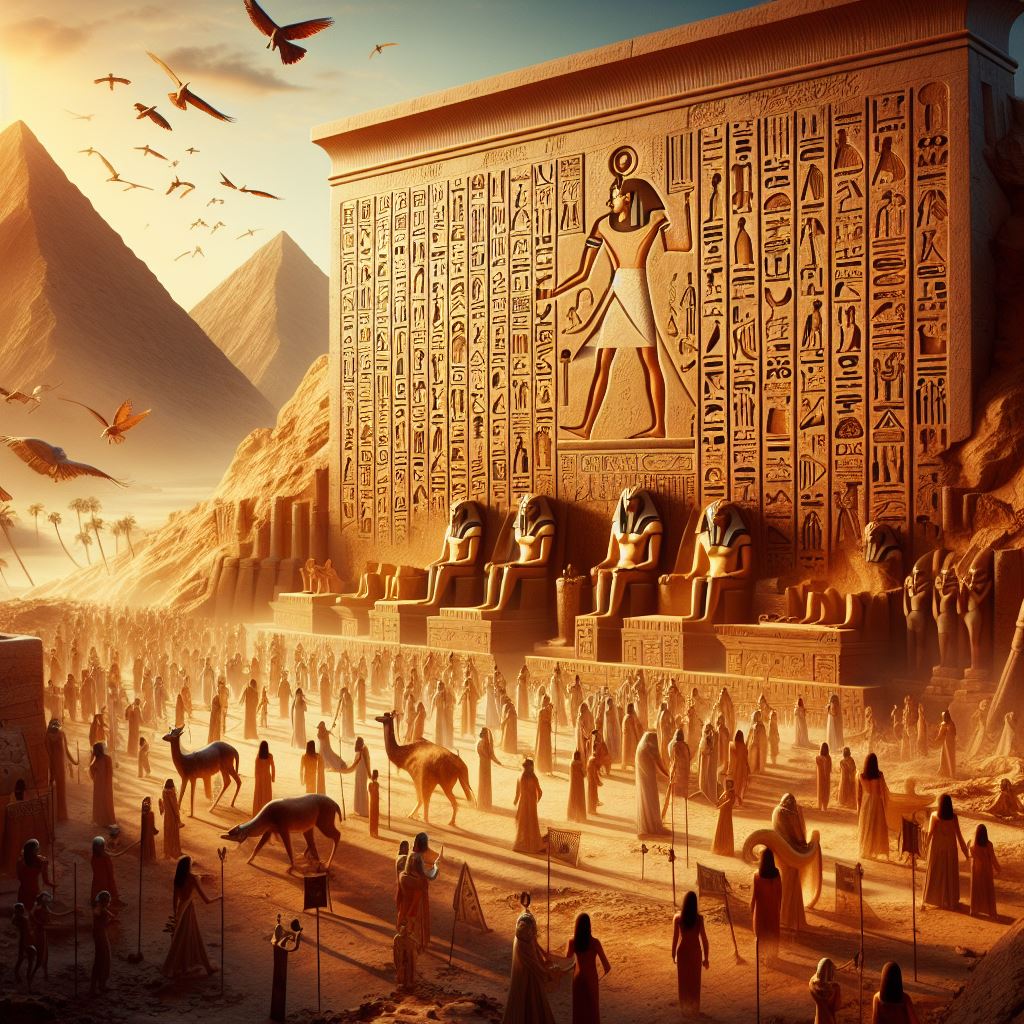Ancient Egyptian hieroglyphics, often referred to as the “Language of the Pharaohs,” is one of the most iconic and fascinating writing systems in human history. Developed and used by the ancient Egyptians for over three millennia, hieroglyphics served as a means of communication, record-keeping, religious expression, and artistic representation.
Origins and Development
Hieroglyphic writing in ancient Egypt has its roots in pictorial symbols and ideograms used for symbolic representation and communication. The earliest examples of Egyptian writing date back to the Predynastic Period (c. 4000 BCE), with simple pictographs depicting objects, animals, and natural elements.
Over time, these pictorial symbols evolved into a more complex system of writing that combined logographic (representing words or morphemes) and phonetic (representing sounds or syllables) elements. Hieroglyphs could convey meaning through both visual images and phonetic signs, allowing for a versatile and expressive writing system.
The term “hieroglyphics” is derived from the Greek words “hieros” (sacred) and “glypho” (carve), reflecting the sacred and ceremonial nature of Egyptian hieroglyphs, which were often inscribed on temple walls, tombs, monuments, and royal artifacts.
Structure and Types of Hieroglyphs
Egyptian hieroglyphs encompass a wide range of symbols representing objects, animals, plants, human figures, deities, abstract concepts, and phonetic elements. Hieroglyphs can be classified into several categories based on their functions and meanings:
- Logograms: Logographic hieroglyphs represent whole words or concepts. For example, the symbol of an eye (the “wedjat” or “Eye of Horus”) represents the concept of protection, healing, and divine power.
- Phonetic Signs: Phonetic hieroglyphs represent sounds or syllables, allowing for the spelling of words and names. These signs include single consonants, vowels, and syllabic signs that combine consonants and vowels.
- Determinatives: Determinatives are non-phonetic symbols used to clarify the meaning of words or indicate their grammatical function. For instance, a determinative for a man or woman might indicate gender, while a determinative for a deity might signify a divine association.
- Cartouches: Cartouches are oval-shaped frames enclosing royal names or titles. They are often used to denote the names of pharaohs, queens, and other royal figures.
Hieroglyphic writing is typically read from right to left or left to right, depending on the direction in which the symbols are facing. The arrangement of hieroglyphs can vary, with vertical columns, horizontal rows, or combinations of both used in inscriptions and texts.
Decipherment and Understanding
The decipherment of Egyptian hieroglyphs was a major breakthrough in the field of Egyptology and linguistic studies. The Rosetta Stone, discovered in 1799 during Napoleon’s expedition to Egypt, played a crucial role in unlocking the secrets of hieroglyphic writing.
The Rosetta Stone is inscribed with a decree issued by King Ptolemy V in 196 BCE, written in three scripts: Egyptian hieroglyphs, Demotic script (a cursive script used for everyday writing), and Greek. Scholars, including Jean-François Champollion, used the bilingual inscriptions on the Rosetta Stone to decipher the hieroglyphic script by identifying commonalities between the Greek text and the hieroglyphic signs.
Through comparative analysis, phonetic mapping, and linguistic research, Champollion and subsequent scholars were able to decipher the phonetic values of many hieroglyphic signs and reconstruct the pronunciation of ancient Egyptian words and names.
Cultural Significance and Usage
Hieroglyphic writing played a central role in ancient Egyptian culture, religion, administration, and art. It was used for a wide range of purposes, including:
- Religious Texts: Hieroglyphs were used to inscribe religious texts, myths, prayers, and hymns on temple walls, papyri, and coffins. These texts often included spells, incantations, and rituals related to the afterlife, divine worship, and cosmic order.
- Historical Records: Hieroglyphs were used to record historical events, royal decrees, diplomatic correspondence, and administrative documents. Royal annals, temple inventories, and legal texts provided insights into the political, social, and economic life of ancient Egypt.
- Funerary Inscriptions: Hieroglyphs were used in funerary contexts to decorate tombs, sarcophagi, and burial chambers. Funerary texts, such as the Pyramid Texts, Coffin Texts, and Book of the Dead, contained instructions, spells, and prayers to guide the deceased in the afterlife.
- Literature and Poetry: Hieroglyphs were used to compose literary works, poems, and stories celebrating the achievements of pharaohs, gods, and legendary figures. The Tale of Sinuhe and the Wisdom Literature are examples of literary texts written in hieroglyphic script.
- Artistic Expression: Hieroglyphs were integrated into artistic compositions, reliefs, statues, and paintings as decorative elements or narrative motifs. The symbols of hieroglyphs added symbolic and aesthetic value to artistic representations.
- Personal Names and Titles: Hieroglyphs were used to write personal names, royal titles, genealogies, and epithets on monuments, stelae, and statues. Names of pharaohs, queens, officials, and deities were often enclosed in cartouches for emphasis.
Conclusion
Ancient Egyptian hieroglyphics represent a remarkable achievement in the development of writing systems and communication technologies. From its origins in pictorial symbols to its complex combination of logographic and phonetic signs, hieroglyphic writing served as a versatile and expressive medium for conveying meaning, preserving knowledge, and embodying cultural identity.
The decipherment of hieroglyphs opened a window into the world of ancient Egypt, allowing scholars to study its history, religion, literature, and society in greater depth. The rich corpus of hieroglyphic texts, inscriptions, and artifacts continues to provide insights into the beliefs, values, achievements, and aspirations of the ancient Egyptians, ensuring that the Language of the Pharaohs remains a vibrant and enduring legacy of human creativity and ingenuity.
